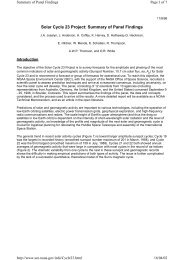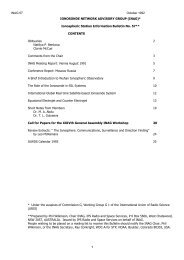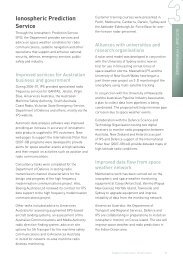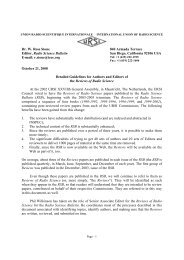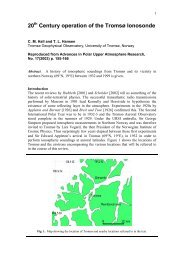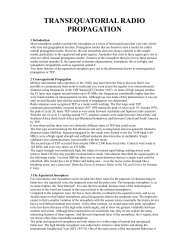UAG-93: Chapters 1 to 5 - URSI
UAG-93: Chapters 1 to 5 - URSI
UAG-93: Chapters 1 to 5 - URSI
Create successful ePaper yourself
Turn your PDF publications into a flip-book with our unique Google optimized e-Paper software.
FIGURE 20.<br />
F]GURE 21.<br />
FIGURE 22.<br />
FIGURE 23.<br />
Results from 2-parameter valley ca)culations, at dip angles from 0 <strong>to</strong> 90'. 59<br />
Results at two djfferent valley depths, for dip angles from 0 <strong>to</strong> 9Oo. 59<br />
Changes in real height and fitting error as the assumed val1ey depth varies. 60<br />
The virtual-height fitting error as a function of assumed va1ley depth. 61<br />
SECTION IO - THE USE OF POLAN<br />
FIGURE 24. Scal ing points for a typical daytime ionogram.<br />
FIGURE 25. Regions where the 0-ray trace should not be scaled.<br />
7I<br />
71<br />
SECTION 11 - THE PROGRAIiI SCION FOR DIGITISING DATA<br />
FIGURE 26. Ionogram layout for digitising, with "off-scale" areas.<br />
76<br />
APPET{DIX A - THE ACCURACY OF N(h) CALCULATIONS<br />
TABLE A1. Real-height errors for a Chapman 1ayer, with modes 1<br />
TABLE A2. Real-height errors for a parabol ic 1ayer, for modes 1<br />
FIGURE AL. The real height profile used <strong>to</strong> produce a large cusp.<br />
TABLE A3. Irrors produced by a large cusp, for modes 1 <strong>to</strong> 6 of<br />
TABLE A4. Cusp errors obtained with different scaled frequency<br />
'i ntervals.<br />
FIGURE A2. Changes in real height caused by changes in the starting<br />
<strong>to</strong> 7 of POLAN.<br />
<strong>to</strong> 7.<br />
POLAN.<br />
correct i on .<br />
B1<br />
B2<br />
B3<br />
B4<br />
B5<br />
B7<br />
APPENDIX B - DIP ANGLE VARIATIOI{S<br />
FIGURE B1. Relat.ive group delays of the extraord.inary and ordinary rays.<br />
FIGURE 82. The group delay ratio Rx.o as a function of dip ang1e.<br />
FIGURE 83. Polynomial f.its <strong>to</strong> the 0- and X-ray group refractive jndices.<br />
B9<br />
B9<br />
90<br />
TABLE ts1.<br />
Enrors in the calculated real-height profile<br />
92<br />
FIGURE 84. The effect of random errors in a slab start analysis.<br />
FIGURE 85. Division of the group-index integration range, at high dip angles.<br />
FIGURE 86. Errors obtained with accurate virtual-height data at different dip angles.<br />
<strong>93</strong><br />
94<br />
95<br />
APPENOIX C - FH HEIGHT VARIATION<br />
FIGURE Ci.<br />
Measured values of gyrofrequency in the .ionosphere.<br />
96<br />
TABLE Cl.<br />
Changes in real and virtual height of a reflecting 1ayer.<br />
9B<br />
FIGURE C2. Changes in the X-ray virtual height due <strong>to</strong> a decrease in FH.<br />
TABLE C2. The relative group retardation of 0 and X rays.<br />
FIGURE C3. The equivalent mono<strong>to</strong>nic distr.ibution for an underlying 1ayer.<br />
FIGURE C4. Virtual heights for a low layer and its equivalent mono<strong>to</strong>nic djstributjon.<br />
TABLE C4. Errors in the slab start calculation, using fixed values of FH.<br />
FIGURE C5. Night E-region profiles used in developing rules for start calculations.<br />
FIGURE C6. Slab start calculatjons using a fixed value of gyrofrequency.<br />
FIGURE C7. Errors obtained from a model ionogram using different values of FH.<br />
FIGURE CB. The separation of "underlying" and "reflectjon" regions for FH.<br />
99<br />
100<br />
101<br />
101<br />
r02<br />
103<br />
105<br />
105<br />
106




